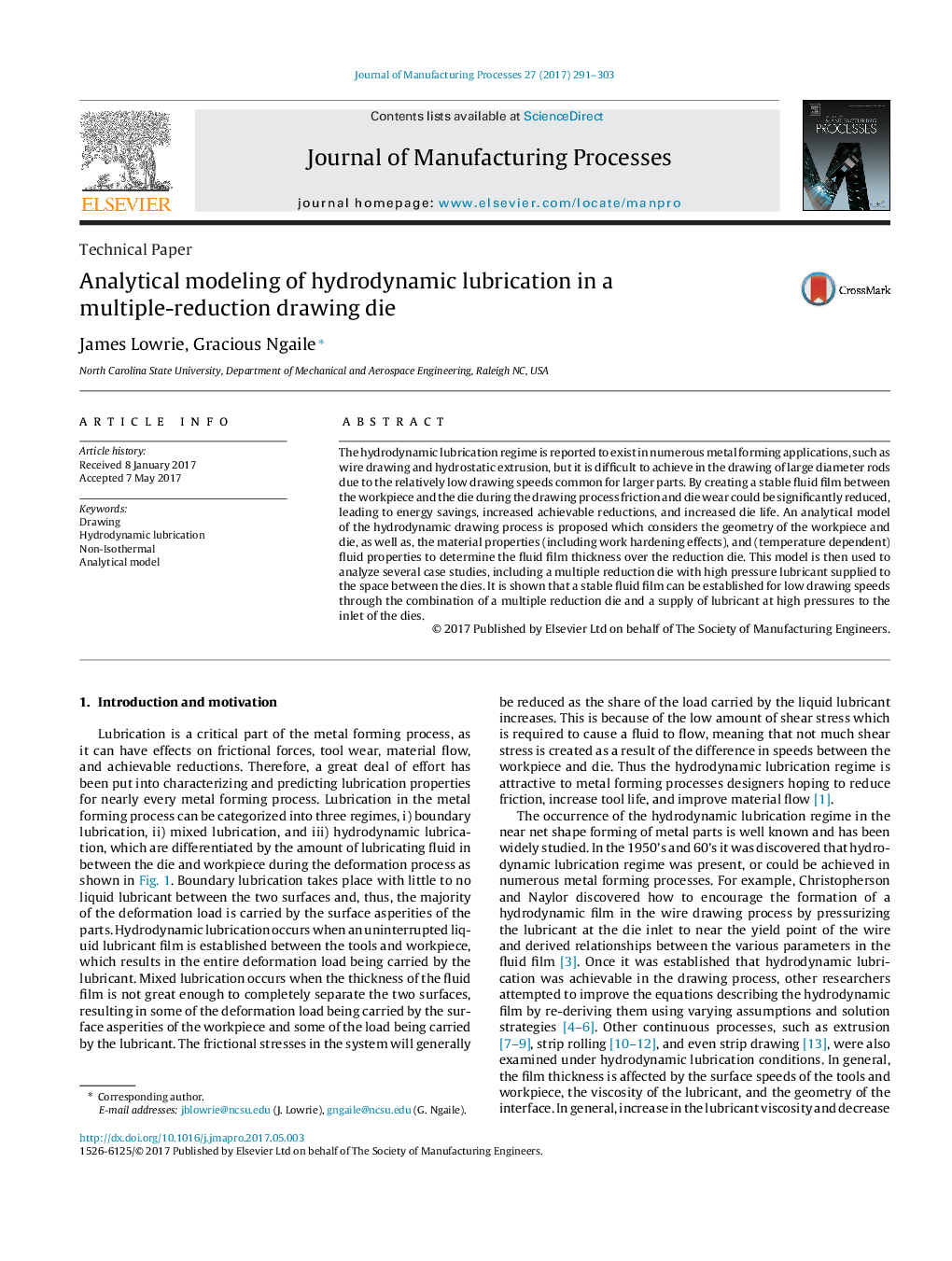| کد مقاله | کد نشریه | سال انتشار | مقاله انگلیسی | نسخه تمام متن |
|---|---|---|---|---|
| 5469436 | 1519229 | 2017 | 13 صفحه PDF | دانلود رایگان |
عنوان انگلیسی مقاله ISI
Analytical modeling of hydrodynamic lubrication in a multiple-reduction drawing die
ترجمه فارسی عنوان
مدلسازی تحلیلی از روانکاری هیدرودینامیکی در یک رسوب چند ضلعی
دانلود مقاله + سفارش ترجمه
دانلود مقاله ISI انگلیسی
رایگان برای ایرانیان
کلمات کلیدی
نقشه برداری روانکاری هیدرودینامیک، غیر ایزوترمال، مدل تحلیلی،
ترجمه چکیده
رژیم روانکاری هیدرودینامیکی گزارش شده است که در برنامه های مختلف تشکیل فلزات، مانند کشش سیم و اکستروژن هیدرواستاتیک وجود دارد، اما در رسم میله های قطر بزرگ به دلیل سرعت نسبتا کم نقاشی برای قطعات بزرگ وجود دارد. با ایجاد یک فیلم مایع پایدار بین قطعه کار و قطعه در طول فرایند رسوب اصطکاک و سایش می تواند به طور قابل توجهی کاهش می یابد، منجر به صرفه جویی در انرژی، افزایش قابل دستیابی و افزایش عمر جان. یک مدل تحلیلی از فرایند طراحی هیدرودینامیکی پیشنهاد شده است که به بررسی هندسه قطعه کار و مرگ و همچنین خواص مواد (از جمله اثرات سخت شدن کار) و (خواص مایع) وابسته به دما می پردازد تا ضخامت فیلم مایع را در مقایسه با کاهش مرگ سپس این مدل برای تجزیه و تحلیل چندین مورد مورد استفاده قرار می گیرد، از جمله یک کاهش دهنده ی چندگانه با روان کننده ی فشار بالا که به فضای بین قالب ها ارائه می شود. نشان داده شده است که یک فیلم مایع پایدار را می توان برای سرعت کم نقاشی از طریق ترکیبی از یک مرگ چند ضلعی و یک منبع روان کننده در فشار بالا به ورودی قالبها ایجاد کرد.
موضوعات مرتبط
مهندسی و علوم پایه
سایر رشته های مهندسی
مهندسی صنعتی و تولید
چکیده انگلیسی
The hydrodynamic lubrication regime is reported to exist in numerous metal forming applications, such as wire drawing and hydrostatic extrusion, but it is difficult to achieve in the drawing of large diameter rods due to the relatively low drawing speeds common for larger parts. By creating a stable fluid film between the workpiece and the die during the drawing process friction and die wear could be significantly reduced, leading to energy savings, increased achievable reductions, and increased die life. An analytical model of the hydrodynamic drawing process is proposed which considers the geometry of the workpiece and die, as well as, the material properties (including work hardening effects), and (temperature dependent) fluid properties to determine the fluid film thickness over the reduction die. This model is then used to analyze several case studies, including a multiple reduction die with high pressure lubricant supplied to the space between the dies. It is shown that a stable fluid film can be established for low drawing speeds through the combination of a multiple reduction die and a supply of lubricant at high pressures to the inlet of the dies.
ناشر
Database: Elsevier - ScienceDirect (ساینس دایرکت)
Journal: Journal of Manufacturing Processes - Volume 27, June 2017, Pages 291-303
Journal: Journal of Manufacturing Processes - Volume 27, June 2017, Pages 291-303
نویسندگان
James Lowrie, Gracious Ngaile,
